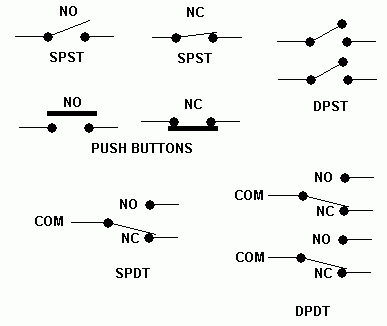
RANDOM PAGE
SITE SEARCH
LOG
IN
SIGN UP
HELP
To gain access to revision questions, please sign up and log in.
Everyone
Switch Properties
Switches are used to make or break a circuit. Here are some common varieties and their names.
- NC Normally Closed
- NO Normally Open
- COM Common or shared connection
- Poles correspond to the number of circuits that can be switched.
- SPST Single Pole Single Throw (The simplest basic on / off switch)
- DPST Double Pole Single Throw (Two of the simplest basic on / off switches)
- SPDT Single Pole Double Throw (One change-over switch)
- DPDT Double Pole Double Throw (Two change-over switches)
Circuit Diagram Symbols
The diagram shows single and double pole switches.

Puzzle
Using two SPDT switches, draw a diagram to show how stair lights work. It should be possible to turn the light on or off both at the top and bottom of the stairs.
Push Button Switch
These come in two varieties: push-to-make (NO) and push-to-break (NC).

Switch Bounce
When a switch is closed, the contacts often bounce causing the circuit to be closed and opened several times until the bouncing has stopped. For something like a lamp or hoover, this does not matter at all but in circuits that count or rely on pulses, switch bounce can stop the circuit working properly.
The switch needs to be de-bounced and this circuit can be used ...

- When the switch is pressed, Reset goes low.
- If the switch bounces, on the first bounce, the flip-flop is reset.
- Later bounces have no further effect so the switch bounce has been removed.
- When the switch is released, Set goes low.
- Once again, the first bounce sets the flip-flop.
- Later bounces have no effect.
More Debouncing Circuits

- The one on the left with the AND gate is less likely to work well.
- The NOT gate is also a Schmitt trigger making these circuits more immune to noise.
reviseOmatic V3
Contacts, ©, Cookies, Data Protection and Disclaimers
Hosted at linode.com, London



![]()

